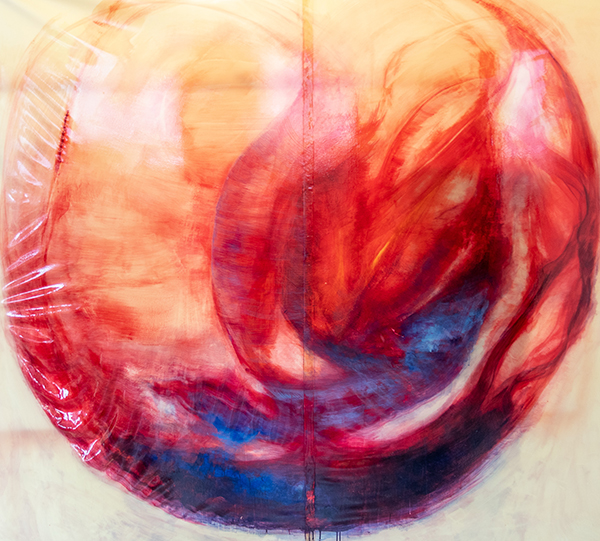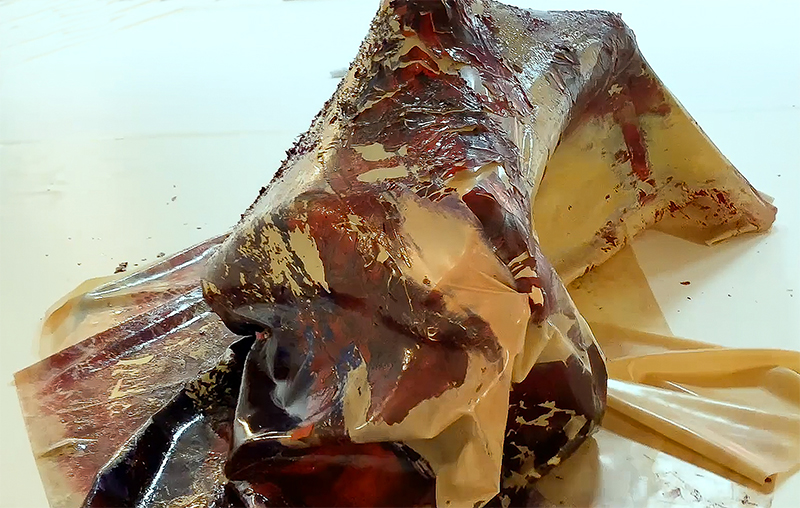As part of our partnership with University College London, Slade School of Fine Art students joined the project's archive and museum research visits
During the research phase of Raw Materials: Plastics, Slade School of Fine Art students were invited to take part in the steering group-led research and archival visits, with a view to using the inspiration of plastics heritage in their own work.
MFA Painting student Rebecca Latourette Connolly was interested in the degradation of plastics mentioned by a conservation scientist at the Victoria and Albert Museum and in response discusses the use of latex within her art practice.
The Material Degradation of Latex and its Relation to Duration in the Human Body
By Rebecca Latourette Connolly
MFA Painting, Slade School of Fine Art, UCL
Latex has long served as an essential material for FX makeup because of its likeness to skin and viscera. It is simple to infer from physical inspection the efficacy of this likeness: latex stretches like skin, tears like skin, it can be held taut and moulded around a skeletal structure. But, like most natural polymers, latex will begin to degrade and lose its structural integrity over time. This is due to exposure to light, heat, oxygen and stress. It is therefore a material that invites a conversation around the limitations of the human body. How does the body react to exterior interventions and how does it endure these over time?
My art practice deals with the conflation of borders between the body and the mind when the body absorbs and reacts to stimulus. I am engaged with the examination of conditions that effect perception such as Synaesthesia and Post-Traumatic Stress Disorder (PTSD): In both conditions an outside sensory stimulus (sight, touch, taste, sound, or smell) provokes a perception in the body that is perceived as alien. In Synaesthesia this may be a related sensory perception such as a sound triggering a colour; in PTSD this may be a perception such as noise triggering a fragmented memory. I am interested in these alien perceptions, their superimposed existence in the body, their durational wear on the body and how they change our understanding of where the edges of our body lie.

In my practice I use latex as a painting ground. By exploiting the material’s propensity to degrade, I intend to make the human body more palpable in the work. I use large quantities of solvent (turpentine) to swathe composition-defining brush strokes in the painting. The solvent thins the latex and causes it to lose its structural integrity, curling under, folding, and billowing outward. This physical reaction resembles inflammation, swelling, skin folds, wrinkles, etc. This reaction also echoes the painted image, which can be likened to internal bodily structures such as the womb, neural networks, or layers of tissue. In this way the latex can be controlled with solvent to billow in certain areas emphasising the painted landscape in three dimensions.
Another process I have used is metal discolouration. Latex is reactive to particular non-ferrous metals and will turn a yellow/brown/green colour over an extended period of time when in close contact with these metals. It can therefore be made to resemble bruises blooming on human skin when the latex is secured with metal hooks or stretched over metal sculpture. This references the reaction of soft tissue to piercing or prodding and the evolution from initial contact to injury.

The last and most important process I have undertaken has to do with the manipulating of finished paintings by hand, to crack and fracture the pictorial surface. This process serves chiefly to subject the painting to violent action, as a body may undergo, but it also allows the tensile strength of the latex to play a role in shaping the composition. As the latex is stretched to its limit the paint flakes and piles, cracks, and bursts off into the atmosphere. This is a precursor to the degradation the latex will exhibit over time. As it ages the material will wear out, lose its stretch and begin to crack and peel away. I like to see this as the latex making reference to its impending lifetime, and taking agency to shape the composition into something that is subject to its growth and decline, like a second skin.
